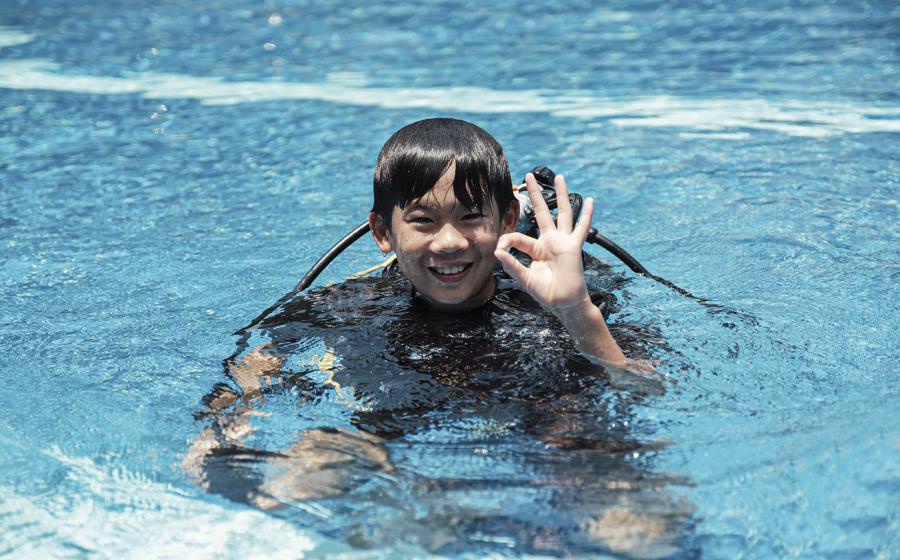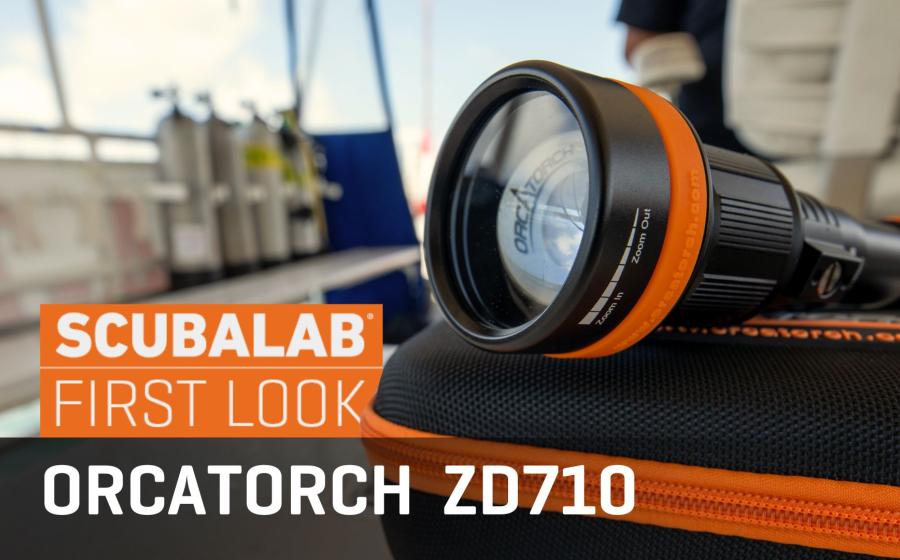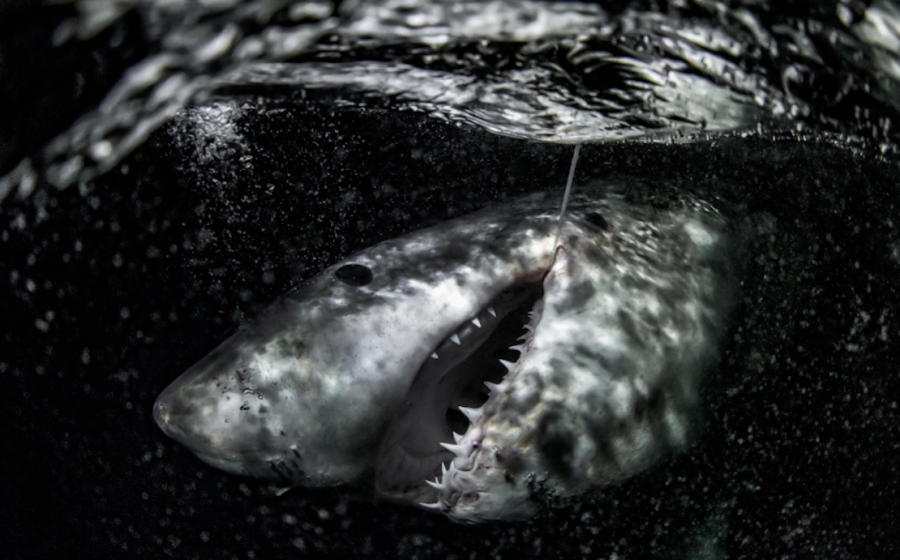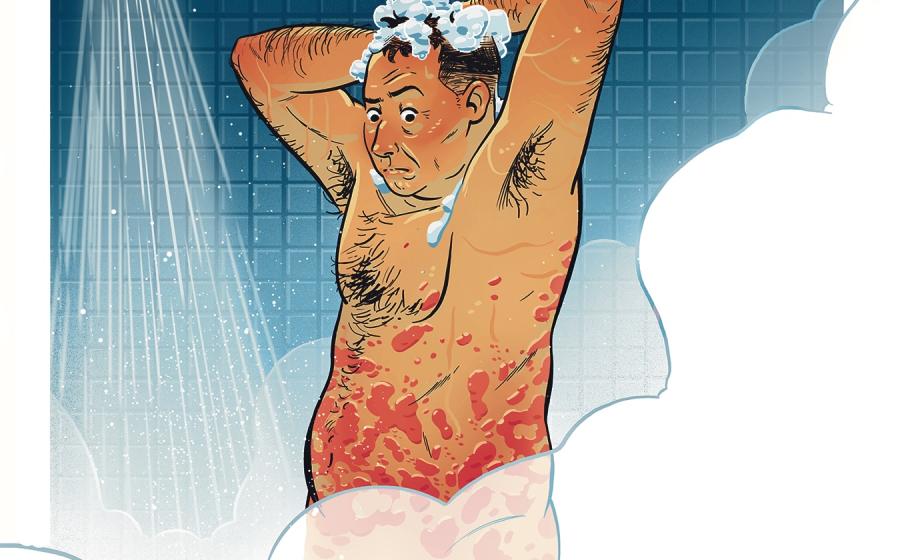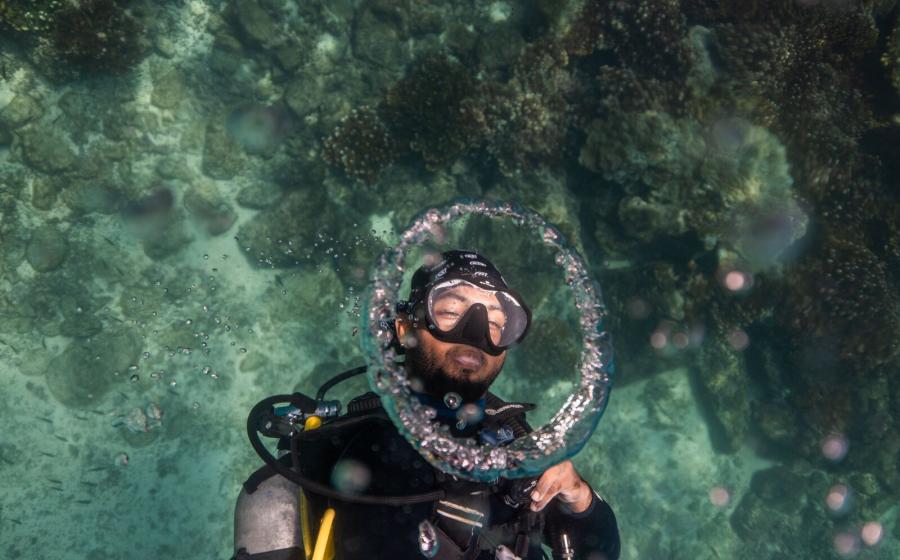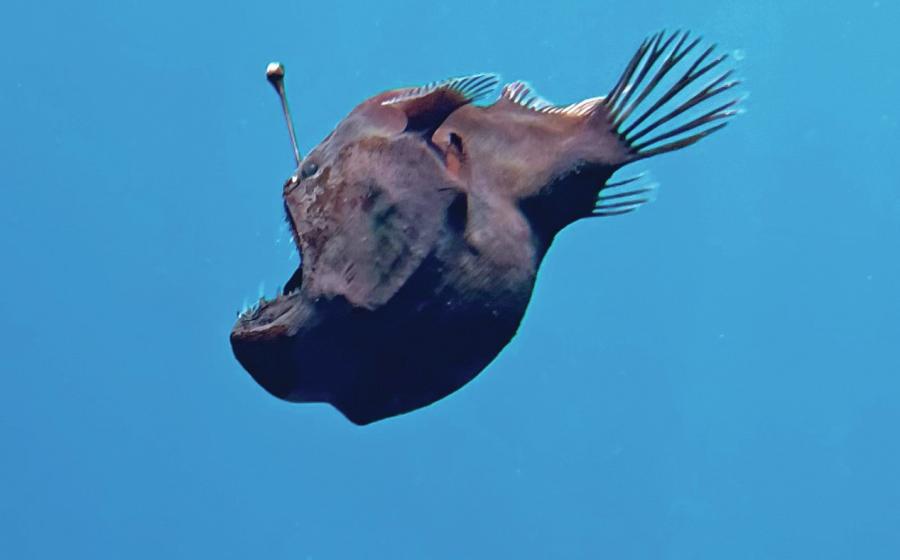The Effects of Bonaire's Fading Night Sky

Jeff StamerDark skies make it possible to photograph the brilliant stars of the Milky Way from Bonaire’s southern tip.
Dark skies make it possible to photograph the brilliant stars of the Milky Way from Bonaire’s southern tip. Bonaire is perhaps the world’s best-loved dive destination, but this sunny island has a dark side—literally. It’s one of a dwindling number of places where you can experience the night sky without the effects of light pollution. Darkness is essential for larval animals and spawning coral—what are the consequences of a lightening world, for Bonaire and the planet?
A carpet of stars arcs over Spelonk Lighthouse as if scattered by an unseen hand. This is Bonaire’s wild east side, where the night sky still appears as it might have in ancient times. It’s a sight underwater photographers Casper Douma and Gerard Cachon know well, as each also specializes in astrophotography.
Construction has exploded on Bonaire since COVID, but it hasn’t yet affected night skies in the island’s east and south. “Those places still have dark skies,” says Douma, a Bonaire resident who teaches astrophotography to visitors. “In certain months you’ll see the Milky Way perfectly.”
Cachon, a professor at the University of Pennsylvania, spends several months a year on Bonaire, where divers typically look down more than up toward the sky. For most people, “the loss of dark skies unfortunately is not a major concern,” he says. “But until you actually experience a dark sky, you have no idea how beautiful the view is above us at night.”
A phrase Douma hears often from students: “So, these places do still exist.”

Lorenzo MittigaTarpon hunt during the night beside a brain coral.
The Dark Side Of Artificial Light
“I like darkness,” Augusto Montbrun says with a smile. Diving at night “gives you a sense of privacy and some suspense. You don’t know what will show up.” The longtime dive operations manager at Buddy Dive Resort is also a cave diver who travels to Florida every year to explore the dark underbelly of the Sunshine State.
Trained as an oceanographer, he’s watched as tourist high-rises and their accompanying glow have sprouted from Venezuela’s Isla Margarita to Aruba to Bonaire. Even 30 years ago, “it was a point of concern,” he says. He gives me an example: Divers are excited about Buddy Dive’s new ostracod night dive, which is offered when conditions are right—but not at Buddy’s Reef. To see the tiny crustaceans, which generate pearly strings of light to attract mates a few days after a full moon, you must have total darkness. “You can’t see it here,” Montbrun says; ostracod dives are done at sites far to the south or north.
He relates another story from a couple of years ago. Sea turtle hatchlings at beaches near the Kralendijk airport mistook lights there for their instinctive guide, the moon. They followed the beams away from the sea and toward the highway—if not for the intervention of Sea Turtle Conservation Bonaire, which managed to redirect the turtles, the result could have been catastrophic.

Lorenzo MittigaAn overhead view of Buddy Dive Resort and its house reef.
Ostracods and turtles are only two of many sea creatures attuned to cycles of darkness. For example, signs around the resort warn against night diving on three evenings in early May—venomous box jellyfish are drawn by the moon to reproduce inshore. “But today there are many ‘moons,’” Montbrun says. The jellies are distracted instead by lights along Kralendijk’s bustling shore.
A couple of days later, we wade in at Buddy’s Reef for our first night dive. Along the edge of the slope it’s an eel convention: sharptailed, chain moray, spotted and green, plus a mottled blue-green eel I can’t identify. Delicate spotted spiny lobsters dance sideways across open ground as tarpon come thrillingly close, then closer. Peering among grains of sand, my mask practically planted, I’m rewarded with minuscule hermit crabs in beautiful shells, one black and white, the other pink and purple.
But it’s when we get back to the wall, in about 9 feet of water, that things really start hoppin’. A huge black-and-white sea urchin appears locked in battle with a couple of spray crabs, and a half dozen species of shrimp scamper about, betrayed by the glint of their eyes. Every crevice reveals something to look at—and talk about over a nightcap and Dutch bar snacks at Blennies, just steps from the dock.
Related Reading: Coldwater Dispatches: Polar Jellyfish

Jeff StamerA spotted moray eel pokes out from some rubble.
Caring Is Sharing
The effect of artificial light on sea creatures is little studied, so far. But surveys suggest nighttime illumination does disrupt marine ecosystems, through reflection from coastal cities, shipping and offshore infrastructure, and altered loud cover attributed to climate change.
Some effects divers can see for themselves. “Bonaire is a real example,” says Ned DeLoach, co-author of the Reef Fish Identification guidebook series. “Dive lights change behavior—you see it with the tarpon. Predators have habituated, on heavily dived or even moderately dived reefs, to use your light for finding prey.”
DeLoach, his partner, Anna, and Montbrun started Buddy Dive’s Marine Life Education Weeks more than 20 years ago to teach divers more about what they see underwater. Last year Eric Riesch, a photographer and managing director of New World Publications, which produces the fish ID guides, took over.
“The effect of artificial light on sea creatures is little studied, so far. But surveys suggest nighttime illumination does disrupt marine ecosystems. ”

Casper DoumaA hawksbill sea turtle swims over a sandy bottom at the popular Bonaire dive site Salt Pier.
“The first question open-water divers always ask is, ‘What is that?’” Riesch says. This year, during weeklong sessions scheduled to begin August 10 and 17, he’s adding more on night diving and coral spawning, which happens in Bonaire from May through November. “Curiosity drives discovery,” he says. “The more divers who witness spawning and life on the reef, the more they’ll want to protect it.”
“Divers are a small population,” Montbrun says. “But if we make the effort to educate them, they will go home and share that knowledge with their grandmother, who never thought about coral reefs. And that helps her feel responsible too.”
Related Reading: Best Destinations for Shore Diving

Eric RieschA Caribbean spiny lobster crawls in the sand on a Bonaire reef.
On The Bright Side
The underwater world isn’t the only one that depends on natural light cycles. Bonaire is also a birder’s paradise, as I discover when I add 14—fourteen—to my lifetime list in less than two weeks, half of them spotted poolside at Plaza Beach & Dive Resort south of downtown Kralendijk.
Birds also depend on darkness—most migrate at night, when the moon and stars aid navigation. Human-made lights create a double whammy: disorientation and collision caused by reflections. Happily for the birds of Bonaire, most of the 111-square-mile island is undeveloped. But that is changing—it’s impossible to miss the construction underway nearly everywhere.
Nonetheless, flocks—and schools—of busy, brightly colored creatures are everywhere. After picking up tanks at Plaza Resort’s new shore-diving pavilion, we plunge in at house reef Eighteen Palms. In about a minute we’re over the drop and admiring every possible kind of reef fish, along with the requisite patrolling tarpon, a lovely, relaxing dive.
Stay Connected! Keep up to date with the latest in diving and underwater adventure. Join PADI Club today for access to exclusive events, dive meet ups and a subscription to Scuba Diving magazine.

Lorenzo MittigaStaghorn coral spawns during a night dive off Bonaire.
A couple of days later we encounter the mother of all schools when we take a dip with Pieter de Groot, an instructor with Dive Friends Bonaire at Delfins Beach Resort. Immense soft corals dot the slope, and we stop a while to watch a hilarious parade of six smooth trunkfish in graduated sizes. But de Groot is clearly on the hunt. At last, as we finish a sunny, shallow safety stop, I see him peering south toward a slightly grayer patch of water, where something silvery glimmers. Baitball! We are enveloped by what seem like millions of bigeye scad and spend 13 minutes suspended in grateful wonderment, privileged to be one with them.
Star Light, Star Bright
Finally, I’m seeing stars.
Sahara sands blowing across the Atlantic have so far obscured night views, although the particle-drenched sunsets are spectacular. The drifting sands provide iron and other essential micronutrients to the seas below, but it’s not looking good for stargazing.

Clockwise from top: Jeff Stamer; Ned Deloach; Casper Douoma; Ned Deloach; Casper Douma; Ned DeloachClockwise from top: The island is a breeding ground for flamingos; a spotfin flounder; a sailfin blenny; a paralarval octopus; a pink spotted cleaner shrimp; a sea butterfly enmeshed in a hydroid colony.
Then Reef Renewal Foundation Bonaire (RRFB) managing director Francesca Virdis offers me hope. It’s coral spawning time, another nighttime event. RRFB divers had been out in force collecting for a new restoration effort, laboratory-assisted reproduction.
I had noticed ceramic stars about the size of a man’s palm around Buddy Dive and on the reef. As soon as I arrive at her office, Virdis shows me trays of those stars in what appears to be clear water. She hands me a black-light flashlight and yellow mask and kills the overhead lights. Instantly, we see hundreds, thousands, of tiny green lights: baby corals! The stars are an artificial substrate to which the coral larvae attach—in fact it’s happening before my eyes as they “settle” on their temporary new homes, which eventually will be moved to ocean nurseries.
This particular spawn is grooved brain coral, an important reef builder. At a precise moment driven by sunset and moon phase—we know when, but don’t fully understand why, Virdis says—the corals release bundles of sperm and eggs. “They look like pearl couscous,” she says.
“Curiosity drives discovery. The more divers who witness spawning and life on the reef, the more they’ll want to protect it.”

Lorenzo MittigaFrench grunts flit around a stand of elkhorn coral.
Brain corals have been hard hit across Florida and the Caribbean by deadly stony coral tissue loss disease, which means many corals are no longer close enough to another colony to achieve fertilization. RRFB helps that along by collecting spawn for lab-assisted fertilization, where eggs develop into swimming larvae within hours. Virdis estimates this collection alone has produced 450,000 viable larvae, far more than would be expected in the wild.
A few days later my buddy and I head north to Karpata, where I remember the coral as spectacular. But it’s been 12 years, and the world has changed. What will we find?
Acres and acres of coral cover a landscape that seems untouched by time. A huge green moray ripples upslope like a bolt of silk unfurling. The only divers in sight, we cruise over gentle folds in the slope, admiring marauding tang gangs and pristine sea fans bigger than I, and soft corals bigger than that. It’s insanely fishy—rivers of blue boga and schools of creole wrasse, sergeant majors, mahogany snapper, striped grunts and goatfish, all in constant motion. Suddenly I realize something big, with a massive, prehistoric-looking head, is coming right at us—it’s a black grouper every inch of 4 feet. Yes, there’s stony coral disease here too, but it’s much less evident, and I feel my heart lifting with every fin kick. As we reluctantly ascend toward the sand, a yard-long rainbow parrotfish, all vivid orange and turquoise, stops us in our tracks, a stunner. We wish we could stay forever.
“Be the butterfly. Live—and dive—like your every action has consequences beyond your understanding.”

Lorenzo MittigaA Reef Renewal Foundation Bonaire diver collects brain coral spawn in a special net to aid in fertilization.
The Butterfly Effect
Turns out, we don’t see the Milky Way, or many stars at all. Those desert sands are unusually persistent—a 2021 analysis by the European Union estimated the frequency and intensity of dust has doubled from 2005 to 2019. The difference may be due to atmospheric disturbances brought on by climate change, but we don’t really know.
The Sahara is a very long way from Bonaire. But I’m reminded of the butterfly effect in chaos theory, the idea that in a deeply interconnected world, the smallest occurrence can influence the whole in dramatic and unexpected ways.
What can divers do about any of this? Be the butterfly. Live—and dive—like your every action has consequences beyond your understanding, for the future health of the ocean and the planet. Because, quite possibly, it does.
Related Reading: Fighting to Save the Caribbean's Coral Reefs
Who Decides?
Coral ready to spawn. Migrating birds. Astronomers. Indigenous people performing ancient rites. All of these earthlings depend on darkness. But who decides where darkness matters and how to preserve it? The answer is murky.
Today, even important observatories are no longer in the dark—according to a 2021 study by Britain’s Royal Astronomical Society, skies over almost two-thirds of major observatories worldwide have brightened as much as 10 percent. The United Nations’ Committee on the Peaceful Uses of Outer Space is studying the challenges for “dark and quiet skies,” particularly relative to the explosive growth of low-Earth-orbit satellites, which now number nearly 10,000.
More than 100 U.N. member countries agree that this is an important topic, which could help establish international policy and the creation of “dark sky oases” to preserve views of the night sky even near urban areas. Citizen advocacy group DarkSky International campaigns for restoration and protection of the nighttime environment; learn more at darksky.org.
Topside Attractions

Tourism Corporation Bonaire
Rincon
Founded in 1527, the oldest settlement in the Dutch Caribbean boasts authentic cuisine and hilltop views at delicious Posada Para Mira as well as tastings of locally made liqueurs and a courtyard bar at the Cadushy Distillery.

Tourism Corporation Bonaire
Jibe City Take a wind-surfing lesson at Sorobon Beach on the east side’s beautiful Lac Bay (jibecity.com), or relax with your toes in the sand at Hang Out Beach and watch others get the hang of it.

Tourism Corporation Bonaire
Bonaire Landsailing Adventures If you put a sail on a motorcycle it might feel something like the Gs you’ll pull in a “blokart,” which surprisingly is entirely wind-driven and suitable for all ages and abilities. It’s especially fun for groups. (landsailingadventures.com)

Jeff Stamer
Birding “Diver’s Paradise” is Bonaire’s motto, but it’s heaven for birders too. Located on the flyway from South America, it’s a breeding ground for American flamingos, just one of 245 species recorded here. (infobonaire.com)

Casper DoumaAstrophotography May to September, try your hand at capturing your own Milky Way images with coaching from pro shooter and Bonaire resident Casper Douma. Complete DSLR sets available for rental. (casperdouma.com)
Need To Know
When to Go Year-round. Temps vary from high 70s in January to 90s in August, but persistent trade winds keep things pleasant. Expect some showers October through December.
Dive Conditions Water temps range from around 78 degrees in winter to 84 in summer. Currents are mild to nonexistent; visibility from 60 to 100 feet is typical. A bathing suit, skin or shorty suffices for many divers. Gloves are not permitted.
Continuing Education/Specialties Reef Renewal Foundation Bonaire works to conserve 13 species of coral; lend a hand with a Discover Reef Renewal Dive or a Reef Renewal Distinctive Specialty certification at any of the dozen local dive shops that support this work. A portion of course fees goes to RRFB. reefrenewalbonaire.org
Fees All travelers must pay a tourist tax of $75 (includes service charge); pay in advance at tourismtax.bonairegov.com and avoid airport lines. A marine park fee of $40—pay in advance at stinapa.bonairenaturefee.org—is required for any water activities.
Getting Around A vehicle is essential— if your stay doesn’t include a drive-and-dive package, local operators like Pickup Rental Bonaire (pickuprentalbonaire.com) are a good bet. They know the terrain and what divers need, and offer extras like four-wheel drive, tank racks, coolers and even a mobile shower.
Accommodations and Diving Buddy Dive Resort This PADI Five Star Career Development Center beloved by divers for decades is located just north of downtown Kralendijk and offers studio, one-, two- and three-bedroom apartments, with packages for boat or shore diving. There’s a full-service dive center just fin kicks from the reef, as well as two swimming pools, casual and fine-dining restaurants, and their famous drive-thru fill station, which makes shore dives anywhere on the island a breeze. buddydive.com
Plaza Beach & Dive Resort This all-inclusive resort south of town is under renovation, and the results so far are stunning, with a new open-air beachside dining and event space, pool, beach bar and shore-diving pavilion. On-site PADI Five Star Resort Toucan Diving offers instruction and boat dives, and it’s recently added new dive boats, including one of the fastest motor cats on the island. plazaresortbonaire.com
Dive Friends Bonaire If your accommodations don’t have an onsite dive shop, Dive Friends Bonaire offers no fewer than eight dive shops and four retail locations around the island for boat dives, shore dives and instruction. divefriendsbonaire.com





